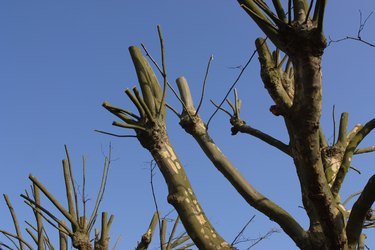
Considered eminently multipurpose and used across nearly all building trades, the reciprocating saw's usefulness extends to the average homeowner's landscape. Although yard maintenance professionals commonly use trade-specific pruning and cutting tools to trim trees, innovative tool manufacturers produce specially reciprocating saw blades for pruning shrubs and trees. While generally unsuitable for felling trees, reciprocating saws quickly slice through both large branches and small twigs. Become familiar with reciprocating saw pruning blades and operation and you can decide if the reciprocating saw is the right tool for your project.
The Right Blade for the Job
Video of the Day
Standard reciprocating saw blades typically lack the tooth pattern and shape to cut through fresh, green lumber. Therefore, reciprocating saw manufacturers offer specially designed blades for tree and shrub pruning projects. Notably, manufacturers strongly advise against using standard wood or metal cutting blades for pruning; although sharp, standard blades' teeth may become stuck in plant materials, causing harm to both operator and tool. Blades suitable for cutting trees and other plants are typically labeled as "pruning" blades.
Video of the Day
Characteristics of a Pruning Blade
Roughly trapezoidal in shape, reciprocating saw pruning blades are generally longer than standard wood cutting blades. Similar to a landscaper's pruning saw or a bow saw, the pruning blade's long, sharply tapered teeth are typically staggered both in length and from left to right long the blade's kerf. The term kerf refers to the width of the slit that a blade creates. The pruning blade's special design removes large chunks of wood and quickly pushes the wood chips from the cut. Designed only for raw power, pruning blades do not create attractive, finish quality cuts.
Capabilities of a Pruning Blade
Although capabilities vary according to blade make and model, most pruning blades perform well on medium to large branches, usually 2 to 5 inches in diameter. Ultimately, the length of the saw blade determines the branch size that the blade can cut. Because of their rapid, back and forth movement, reciprocating saws are generally unsuitable for cutting tiny, flexible branches; tiny branches often escape the blade's teeth or become caught in the saw's nose guard. Additionally, reciprocal saw blades are far too short to cut through most tree trunks.
Alternative Tree Maintenance Tools
Several common yard maintenance tools handle tree trimming tasks beyond the capabilities of a reciprocating saw. Available both electric and gas operated, hedge trimmers quickly cut and shape the small, flexible branches that often escape reciprocating saws. Hedge trimmers feature a set of two blades, one fixed and one that reciprocates. The hedge trimmer's reciprocating blade traps small or thin material against the fixed blade. Alternatively, chain saws handle the limbs and trunks too large for a reciprocating saw.